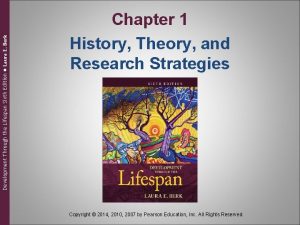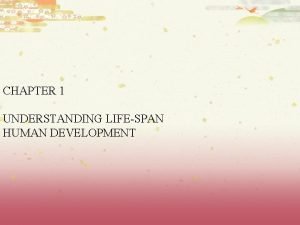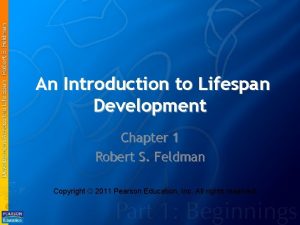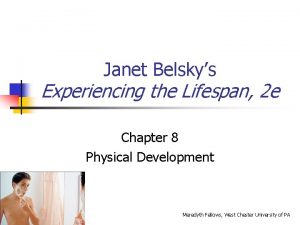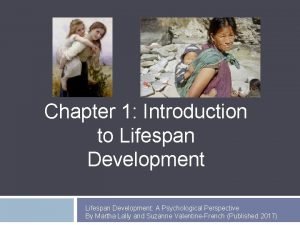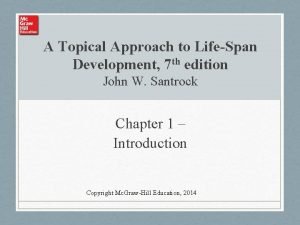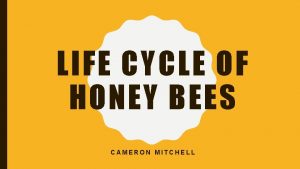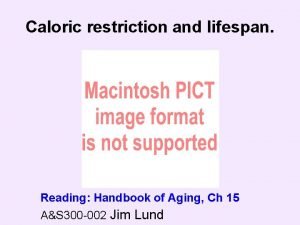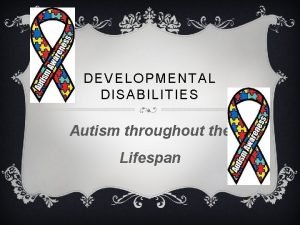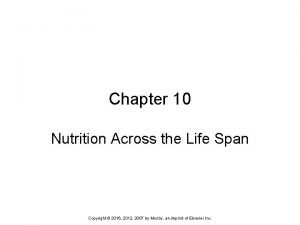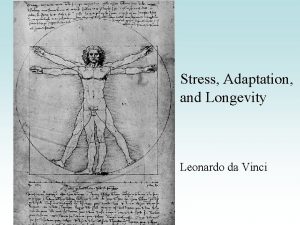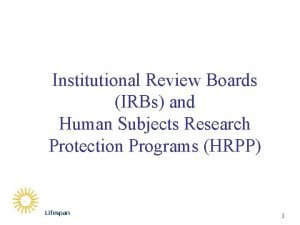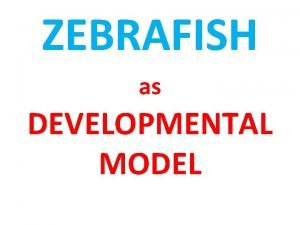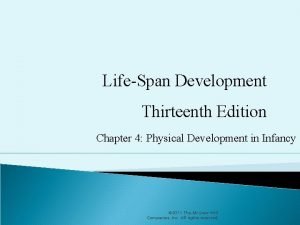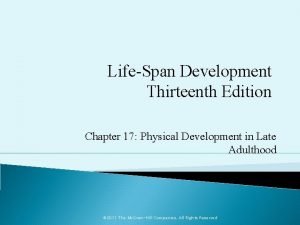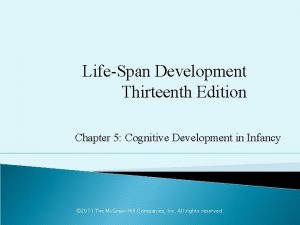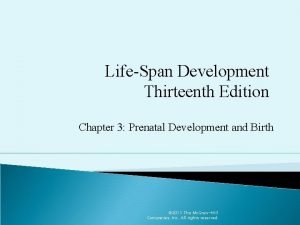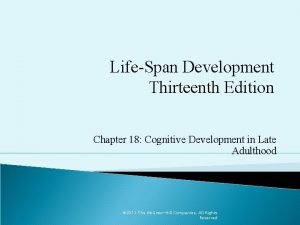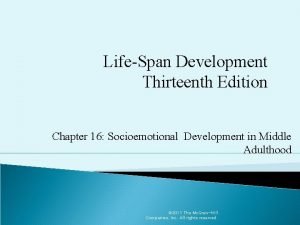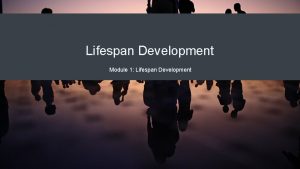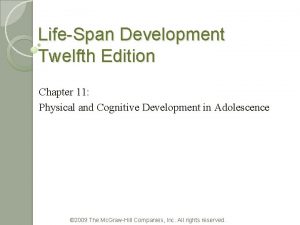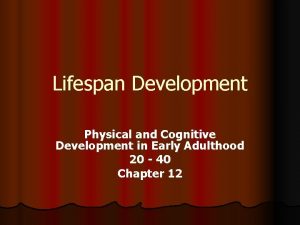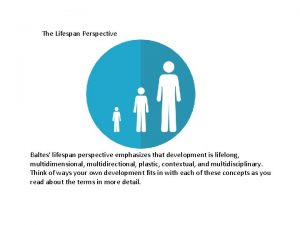LifeSpan Development Thirteenth Edition Chapter 11 Physical and
































- Slides: 32

Life-Span Development Thirteenth Edition Chapter 11: Physical and Cognitive Development in Adolescence © 2011 The Mc. Graw-Hill Companies, Inc. All rights reserved.

The Nature of Adolescence § G. Stanley Hall (1904): adolescence is a time of “storm and stress” § Recent research has found that adolescents have a healthy selfimage § Most adolescents successfully negotiate the path from childhood to adulthood © 2011 The Mc. Graw-Hill Companies, Inc. All rights reserved. 2

Physical Changes § Puberty: a period of rapid physical maturation involving hormonal and bodily changes that occur primarily during early adolescence § Sexual Maturation, Height, and Weight § § § Menarche is a girl’s first menstruation Marked weight and height gains Pubic hair growth Facial and chest hair growth in males Breast growth in females © 2011 The Mc. Graw-Hill Companies, Inc. All rights reserved. 3

Physical Changes © 2011 The Mc. Graw-Hill Companies, Inc. All rights reserved. 4

Physical Changes § Puberty § Hormonal Changes § Hormones: chemicals secreted by the endocrine glands and carried throughout the body by the bloodstream § Increases in testosterone and estradiol © 2011 The Mc. Graw-Hill Companies, Inc. All rights reserved. 5

Physical Changes § Puberty § Timing and Variations in Puberty § Average of menarche has declined significantly since mid-19 th century § Improved nutrition and health § For boys, pubertal sequence typically begins from age 10– 13 ½ years. For girls it appears between 9 and 15 years § Precocious Puberty – the very early onset and rapid progression of puberty © 2011 The Mc. Graw-Hill Companies, Inc. All rights reserved. 6

Physical Changes © 2011 The Mc. Graw-Hill Companies, Inc. All rights reserved. 7

Physical Changes § Puberty § Body Image § Preoccupation with body image is especially strong throughout adolescence § Girls are generally less happy with their bodies than boys and become more dissatisfied over time © 2011 The Mc. Graw-Hill Companies, Inc. All rights reserved. 8

Physical Changes § Puberty § Early and Late Maturation § Boys § Early-maturing boys view themselves more positively and have more successful peer relations; late maturing boys report a stronger sense of identity in their 30 s § Girls § Early-maturing girls show greater satisfaction early but less satisfaction later and are more likely to smoke, drink, be depressed, have an eating disorder, struggle for earlier independence, have older friends, date earlier, and have earlier sexual experiences © 2011 The Mc. Graw-Hill Companies, Inc. All rights reserved. 9

Physical Changes © 2011 The Mc. Graw-Hill Companies, Inc. All rights reserved. 10

Physical Changes § The Brain § Adolescents’ brains undergo significant structural changes § Corpus callosum thickens; improves adolescents’ ability to process information § Amygdala develops earlier than the prefrontal cortex (involved in higher-level cognitive processes) § Underdeveloped prefrontal cortex cannot control their passions © 2011 The Mc. Graw-Hill Companies, Inc. All rights reserved. 11

The Brain © 2011 The Mc. Graw-Hill Companies, Inc. All rights reserved. 12

Physical Changes § Adolescent Sexuality § Atime of sexual exploration and experimentation, sexual fantasies and realities, and incorporating sexuality into one’s identity § Adolescents who view more sexual content on television are more likely to initiate sexual intercourse earlier © 2011 The Mc. Graw-Hill Companies, Inc. All rights reserved. 13

Physical Changes § Adolescent Sexuality § Developing a Sexual Identity Involves § Learning to manage sexual feelings § Developing new forms of intimacy § Learning skills to regulate sexual behavior § Sexual Identity Includes § § Activities Interests Styles of behavior Indication of sexual orientation § Gay males and lesbians struggle with same-sex attractions © 2011 The Mc. Graw-Hill Companies, Inc. All rights reserved. 14

Physical Changes § Adolescent Sexuality § The Timing of Adolescent Sexual Behaviors § Sexual initiation varies by country, gender, and other socioeconomic characteristics § 63% of U. S. 12 th graders had experienced intercourse compared with 34% of 9 th graders © 2011 The Mc. Graw-Hill Companies, Inc. All rights reserved. 15

Physical Changes Adolescent Sexuality © 2011 The Mc. Graw-Hill Companies, Inc. All rights reserved. 16

Physical Changes § Adolescent Sexuality § Risk Factors in Adolescent Sexual Behavior § Low parental monitoring is linked with early initiation of sexual activity, more sexual partners, and less condom use § Drug use, delinquency, and school-related problems § Socioeconomic Status § Family/Parenting § Peers § Academic Achievement © 2011 The Mc. Graw-Hill Companies, Inc. All rights reserved. 17

Physical Changes § Adolescent Sexuality § Contraceptive Use § Adolescents are increasing their use of contraceptives § U. S. has much lower condom use and pill use than European countries § Sexually transmitted infections (STIs) § Every year 3 million American adolescents acquire and STI © 2011 The Mc. Graw-Hill Companies, Inc. All rights reserved. 18

Physical Changes Adolescent Sexuality © 2011 The Mc. Graw-Hill Companies, Inc. All rights reserved. 19

Physical Changes § Adolescent Sexuality § Adolescent Pregnancy § Creates health risks for baby and mother § U. S. has 1 of the highest rates in the world § Low birth weight, neurological problems, childhood illness § Mothers drop out of school and never catch up economically © 2011 The Mc. Graw-Hill Companies, Inc. All rights reserved. 20

Issues in Adolescent Health § Poor health habits and early death in adulthood begin during adolescence § Nutrition and Exercise § 17% of 12– 19 -year-olds are overweight § Decreased intake of fruits and vegetables and less exercise § Sleep Patterns § Only 31% of U. S. adolescents sleep 8 or more hours a night © 2011 The Mc. Graw-Hill Companies, Inc. All rights reserved. 21

Issues in Adolescent Health § Leading Causes of Death in Adolescence: § Accidents § Homicide § Suicide © 2011 The Mc. Graw-Hill Companies, Inc. All rights reserved. 22

Issues in Adolescent Health § Substance Use and Abuse § United States has one of the highest rates of adolescent drug use of any industrialized nation § Adolescent alcohol and cigarette consumption has declined in recent years § Use of painkillers (Vicodin, Oxycontin) is increasing § The Roles of Development, Parents, Peers and Education © 2011 The Mc. Graw-Hill Companies, Inc. All rights reserved. 23

Issues in Adolescent Health § Eating Disorders § Anorexia Nervosa: the relentless pursuit of thinness through starvation § Three Main Characteristics: § Weight less than 85% of what is considered normal for a person’s age and height § An intense fear of gaining weight that does not decrease with weight loss § Having a distorted image of their body shape § 10 times more likely to occur in females than males © 2011 The Mc. Graw-Hill Companies, Inc. All rights reserved. 24

Issues in Adolescent Health § Eating Disorders § Bulimia Nervosa: eating disorder in which the individual consistently follows a binge-and-purge pattern § Most bulimics: § Are preoccupied with food § Have an intense fear of becoming overweight § Are depressed or anxious § Have a distorted body image § Typically fall within a normal weight range © 2011 The Mc. Graw-Hill Companies, Inc. All rights reserved. 25

Adolescent Cognition § Piaget’s Theory § Formal Operational Stage (age 11+ years): § More abstract than concrete operational thought § Increased verbal problem-solving ability § Increased tendency to think about thought itself § Thoughts of idealism and possibilities § More logical thought § Hypothetical-deductive reasoning: involves creating a hypothesis and deducing its implications © 2011 The Mc. Graw-Hill Companies, Inc. All rights reserved. 26

Adolescent Cognition § Adolescent Egocentrism: § Heightened self-consciousness of adolescents § Imaginary Audience: adolescents’ belief that others are as interested in them as they themselves are § Personal Fable: involves a sense of uniqueness and invincibility § Invincibility attitudes © 2011 The Mc. Graw-Hill Companies, Inc. All rights reserved. 27

Adolescent Cognition § Information Processing § Executive functioning § Higher-order cognitive activities such as reasoning, making decisions, monitoring thinking critically, and monitoring one’s cognitive process § Decision Making § Critical Thinking © 2011 The Mc. Graw-Hill Companies, Inc. All rights reserved. 28

Schools § The Transition to Middle or Junior High School: § Drop in school satisfaction § Less stressful when students have positive relationships § Top-Dog phenomenon – move from being oldest, biggest, and most powerful in elementary school to youngest, smallest, and least powerful in middle school © 2011 The Mc. Graw-Hill Companies, Inc. All rights reserved. 29

Schools § Effective Schools for Young Adolescents: § Develop smaller communities that lessen impersonality of middle schools § Lower student-counselor ratios to 10 -to-1 § Involve parents and community leaders § Boost students’ health and fitness with more programs § Integrate several disciplines in a flexible curriculum § Provide public health care © 2011 The Mc. Graw-Hill Companies, Inc. All rights reserved. 30

Schools § High School § Many students graduate with inadequate reading, writing, and mathematical skills § High schools should discourage dropping out © 2011 The Mc. Graw-Hill Companies, Inc. All rights reserved. 31

Schools § Extracurricular Activities § A wide array of activities can be very beneficial § Service Learning: a form of education that promotes social responsibility and service to the community © 2011 The Mc. Graw-Hill Companies, Inc. All rights reserved. 32
 Development through the lifespan 6th edition
Development through the lifespan 6th edition Lifespan development third edition
Lifespan development third edition Lifespan development third edition
Lifespan development third edition Chapter 9 lifespan development
Chapter 9 lifespan development Introduction to lifespan development
Introduction to lifespan development Exploring lifespan development chapter 1
Exploring lifespan development chapter 1 Bioecological approach
Bioecological approach Janet belsky
Janet belsky Guidance counselling and lifespan development
Guidance counselling and lifespan development Lifespan development a psychological perspective
Lifespan development a psychological perspective A topical approach to lifespan development
A topical approach to lifespan development Using mis (10th edition) 10th edition
Using mis (10th edition) 10th edition Using mis 10th edition
Using mis 10th edition Snow leopard reproduction
Snow leopard reproduction Pelican eel facts
Pelican eel facts Petit fours display
Petit fours display Splendour beetle lifespan
Splendour beetle lifespan Honeybee lifecycle
Honeybee lifecycle Juan ponce de leon lifespan
Juan ponce de leon lifespan Henry hudson 2nd voyage
Henry hudson 2nd voyage Lifespan of every animal
Lifespan of every animal The developing person through the life span 9th edition
The developing person through the life span 9th edition Prairie dogs fun facts
Prairie dogs fun facts Autism lifespan
Autism lifespan Nutrition across the lifespan
Nutrition across the lifespan Eagle longest lifespan
Eagle longest lifespan Da vinci lifespan
Da vinci lifespan Lifespan irb
Lifespan irb Henry hudson fun facts
Henry hudson fun facts Economic importance of physalia
Economic importance of physalia Lifespan of platelets
Lifespan of platelets La vecchio
La vecchio Zebrafish lifespan
Zebrafish lifespan
